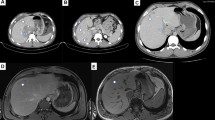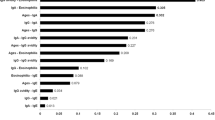Abstract
The aim of this investigation was to study the frequency of visceral larva migrans (VLM) granulomas in autopsies at a Children’s Reference Hospital in Vitoria, ES Brazil, where anti-Toxocara antibodies are frequently detected in the serum of children admitted at the hospital. Two liver fragments from 310 autopsies of children aged between 1 and 15 years were paraffin embedded, and sections were stained with hematoxylin and eosin and submitted to detection of Toxocara antigens using a rabbit anti-Toxocara serum. Among the 24 cases with granulomatous lesions, ten had eosinophil-rich granulomas positively stained with the anti-Toxocara serum. Some were typical epithelioid granulomas, with a positive reaction in multinucleated giant cells, epithelioid cells, or necrotic debris. The results showed that VLM granulomas are the most frequent granulomatous hepatitis in children in our county. This agrees with the high prevalence of anti-Toxocara antibodies in the serum of children admitted to the Children’s Reference Hospital. The 3.2% frequency of liver VLM granulomas in autopsies is less than the 30–39% frequency of positive serology in these children, probably reflecting the low larval burden in infected children.


Similar content being viewed by others
References
Beaver PC (1956) Larva migrans. Exp Parasitol 5:587–621
Chandrashekar R, Curtis KC, Weil GJ (1995) Molecular characterization of a parasite antigen in sera from onchocerciasis patients that is immunologically cross-reactive with human keratin. J Infect Dis 171:1586–1592
De Brito T, Chieffi PP, Peres BA, Santos RP, Gayotto LCC, Vianna MR, Porta G, Alves VA (1994) Immunohistochemical detection of Toxocara antigen in human biopsies. Int J Surg Pathol 2:117–124
Despommier D (2003) Toxocariasis: clinical aspects, epidemiology, medical ecology, and molecular aspects. Clin Microbiol Rev 16: 265–272
Fuchs E, Marchuk D (1983) Type I and type II keratins have evolved from lower eukaryotes to form the epidermal intermediate filaments in mammalian skin. Proc Natl Acad Sci USA 80: 5857–5861
Gems D, Ferguson CJ, Robertson BD, Nieves R, Page AP, Blaxter ML, Maizels RM (1995) An abundant, trans-spliced mRNA from Toxocara canis infective larvae encodes a 26-kDa protein with homology to phosphatidylethanolamine-binding proteins. Biol Chem 270:18517–18522
Kaplan KJ, Goodman ZD, Ishak KG (2001) Eosinophilic granuloma of the liver: a characteristic lesion with relationship to visceral larva migrans. Am J Surg Pathol 25:1316–1321
Masuoka J, Guthrie LN, Hazen KC (2002) Complications in cell-surface labelling by biotinylation of Candida albicans due to avidin conjugate binding to cell-wall proteins. Microbiology 148(Pt 4):1073–1090
Moreira-Silva SF, Leao ME, Mendonca HF, Pereira FE (1998) Prevalence of anti-Toxocara antibodies in a random sample of inpatients at a children’s hospital in Vitoria, Espirito Santo, Brazil. Rev Inst Med Trop Sao Paulo 40:259–261
Moreira-Silva SF, Leite AL, Brito EF, Pereira FE (2002) Nematode infections are risk factors for staphylococcal infection in children. Mem Inst Oswaldo Cruz 97:395–399
Moreira-Silva SF, Pereira FE (2000) Intestinal nematodes, Toxocara infection, and pyogenic liver abscess in children: a possible association. J Trop Pediatr 46:167–172
Musso C, Lemos EM, Tsanaclis AMC, Pereira FEL (2006) Toxocara infection is not associated with viral or bacterial central nervous system infection in children. Neuropediatrics 37:126–129
Musso C, Castelo JS, Tsanaclis AMC, Pereira FE (2006) Visceral larva migrans granulomas in liver and central nervous system of children who died of bacterial or viral meningitis. Clin Neuropathol 25:288–290
Nichols RL (1956) The etiology of visceral larva migrans. I. Diagnostic morphology of infective second-stage Toxocara larvae. J Parasitol 42:349–362
Pawlowski Z (2001) Toxocariasis in humans: clinical expression and treatment dilemma. J Helminthol 75(4):299–305
Pereira FE, Musso C, Castelo JS (1999) Pathology of pyogenic liver abscess in children. Pediatr Dev Pathol 2:537–543
Salfelder K, De Liscano TR, De Mendelovici M (1973) Visceral eosinophilic granulomas. Beitr Pathol 149:420–428
Smith HV, Quinn R, Bruce RG, Girdwood WA (1982) Development of the serological response in rabbits infected with Toxocara canis and Toxascaris leonina. Trans R Soc Trop Med Hyg 76:89–94
Taylor MR, Keane CT, O’Connor P, Mulvihill E, Holland C (1988) The expanded spectrum of toxocaral disease. Lancet 1:692–695
Author information
Authors and Affiliations
Corresponding author
Rights and permissions
About this article
Cite this article
Musso, C., Castelo, J.S., Tsanaclis, A.M.C. et al. Prevalence of Toxocara-induced liver granulomas, detected by immunohistochemistry, in a series of autopsies at a Children’s Reference Hospital in Vitoria, ES, Brazil. Virchows Arch 450, 411–417 (2007). https://doi.org/10.1007/s00428-007-0388-5
Received:
Revised:
Accepted:
Published:
Issue Date:
DOI: https://doi.org/10.1007/s00428-007-0388-5




